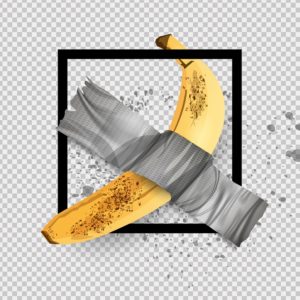Who would’ve thought that a banana and some duct tape could cause a controversy? And yet, when the potassium-rich fruit was duct-taped to a wall at the Art Basel Miami fair, sold for $120,000, and eaten, newspapers across the country made it infamous. The publicity stunt had worked.
People naturally asked how any of it was art, to which the Washington Post’s art critic, Sebastian Smee, shook a finger and replied, “Artists decide whether something is art.”
The history of art tells us something quite different. Up until recently, patrons decided what was art, and if artists wanted to eat, they produced what the patrons wanted. They did not decide whether something was art.
In the Italian Renaissance, an artist could unveil his work to admiring cheers. The public did not shake their heads or shrug their shoulders. Artists communicated something the public understood, something that was important to them. Not only did the public recognize art as art, they understood that it had meaning and value.
When the public cannot recognize “art” as art, it’s not the public’s fault. The artist has failed.
Yet art critic Smee tells us that we’re not supposed to ask whether something is art. He says that when we ask that question, it’s because we want the answer to be, “It’s not.”
I beg to differ. In my experience as a teacher of college students, when people ask a question, they really do want an answer. It’s unfortunate that, in the case of the duct-taped banana, an answer has not been provided. We’re told we’re asking the wrong questions.
Imagine raising your hand in class and the teacher telling you that you’re asking the wrong questions!
The problem is not our questions, but the inability of the art world to provide answers. That’s because the art world itself is confused. As Smee makes clear, “Creativity often confounds us. It cracks open the assumptions and expectations to which our minds unthinkingly cling.”
But does it? If anything, the duct-taped banana only confirms people’s assumptions about the stupidity of contemporary art. It does not “confound” anyone. It’s boring. No “expectations” have been “cracked open.” We’ve come to expect such gimmicks.
Ever since the French artist Duchamp hung a urinal on a gallery wall in 1917, artists have been attempting to shock and confound. This has been going on for over a hundred years. That does not prevent Smee from telling us that artists are “so far ahead of the rest of the culture.”
But are they? Contemporary artists think they’re being so avant-garde, so innovative and forward thinking, but they’re really just working in a tired, old tradition that stinks of grandma’s mothballs. The duct-taped banana is cliched and old-fashioned.
I suspect that many contemporary artists are secretly aware of their own lack of talent and technique, hence the reason they want to “subvert” anything that requires talent and technique. As Smee points out, “In contemporary art, once-clear categories get smashed all the time.” My point exactly. If you cannot create something beautiful and meaningful, you can “smash categories” and make something ugly and stupid.
But if a mechanic can’t build an engine, he doesn’t make a career out of smashing engines. And if a brain surgeon can’t operate on a brain, he doesn’t make a career out of smashing brains. Yet here are these contemporary artists, smashing up art and, apparently, making a career out of it.
It’s not the public that has made “art” a dirty joke. It’s the artists themselves, along with the critics who enable them. They wonder why they’re not appreciated. They could take a lesson from the Renaissance.
The fact remains that despite contemporary artists, the public continues to believe in the power of art. If this were not the case, there would be no public outcry when a banana gets duct-taped to a wall and deemed “art.” If people did not believe that art should communicate something valuable, no one would lift an eyebrow when it communicated something worthless.
When the public finds a piece of art stupid, chances are it is stupid. Artists can continue to produce trash, and the public will continue to trash them.

